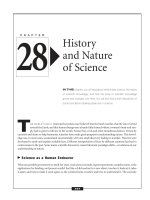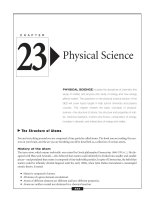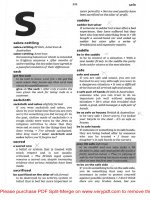2.9 Ships and boats (physical science)
Bạn đang xem bản rút gọn của tài liệu. Xem và tải ngay bản đầy đủ của tài liệu tại đây (3.33 MB, 14 trang )
Genre
Nonfiction
Comprehension Skill
Infer
Text Features
• Call Outs
• Captions
• Glossary
Science Content
Energy
Scott Foresman Science 2.9
ISBN 0-328-13795-2
ì<(sk$m)=bdhjfe< +^-Ä-U-Ä-U
Vocabulary
Extended Vocabulary
conductor
energy
fuel
reflect
shadow
solar energy
source
ballast
foil
harbor
hull
mast
sail
Picture Credits
Every effort has been made to secure permission and provide appropriate credit for photographic material.
The publisher deeply regrets any omission and pledges to correct errors called to its attention in subsequent editions.
Photo locators denoted as follows: Top (T), Center (C), Bottom (B), Left (L), Right (R), Background (Bkgd).
Opener: ©Richard Cummins/Corbis; 7 Phil Schermeister/Corbis; 11 ©Richard Cummins/Corbis; 13 Mike Segar/Reuters/Corbis;
14 Craig Aurness/Corbis; 19 Bob Rowan/Progressive Image/Corbis; 23 Richard Hamilton Smith/Corbis.
Unless otherwise acknowledged, all photographs are the copyright © of Dorling Kindersley, a division of Pearson.
ISBN: 0-328-13795-2
Copyright © Pearson Education, Inc. All Rights Reserved. Printed in the United States of America.
This publication is protected by Copyright, and permission should be obtained from the publisher prior to any
prohibited reproduction, storage in a retrieval system, or transmission in any form by any means, electronic,
mechanical, photocopying, recording, or likewise. For information regarding permission(s), write to
Permissions Department, Scott Foresman, 1900 East Lake Avenue, Glenview, Illinois 60025.
3 4 5 6 7 8 9 10 V010 13 12 11 10 09 08 07 06 05
What did you learn?
1. How do people use ships and boats?
2. How does a ballast work?
3.
People use
different kinds of energy to move
ships and boats through water. Write
to tell aboutby
three
types
of fuel or
Marilyn
Greco
energy used to move ships and
boats. Use examples from the book
as you write.
4.
Infer Over time, people have
discovered new forms of energy that
can make boats bigger and faster. If
these boats are easier to use, why do
you think people still use muscle- and
wind-powered boats?
What You Already Know
We use energy every day. We use energy
when we run, when we sleep, and when we
breathe. Anything that can do work and cause
change has energy.
Solar energy is heat and light from the Sun.
Green plants get energy from the Sun. Animals
get energy from food. People get energy from
many different kinds of healthful foods.
Sunlight is a source of heat. A source is a
place from which things come. Fuel is something
that is burned to make heat.
Heat moves from hot places
to cool places. A conductor is
something that lets heat move
easily through it. Metal is a good
conductor of heat.
Light is a form of energy.
It reflects when it bounces off
something. A shadow happens
when something blocks light. Other
kinds of energy include motion, wind,
sound, and electricity.
In this book, you will read about
boats and ships. What do boats and
ships have to do with energy? People
use different kinds of boats. People
also use different kinds of energy to
move boats and ships through water.
Fruits and
vegetables
get energy
from the Sun.
2
paddles
3
On the Water
Have you ever been to a lake, a large river,
or the seashore? If you have, you probably saw
ships and boats in action.
Ships and boats come in all shapes and sizes.
There are small canoes, medium-sized tugboats,
and huge oil tankers. All boats,
no matter what size, need
energy to move
through water.
mast
sail
hull
This Chinese sailing
vessel is called a junk.
4
This cruise liner was a passenger ship. It has several decks,
or levels. It carried several thousand people.
5
Muscle Power
People began making boats more than
ten thousand years ago. At first, they made
simple rafts. Then people found a new way to
make boats. They carved out the trunks of trees
to make long, narrow boats.
These early boats, or canoes, needed energy
to push them through water. People powered
these boats, using their own muscle power.
People pushed with wooden poles or rowed with
oars. They could use their boats to hunt, fish,
and carry goods from place to place.
Human muscle power was needed
to row this early Viking boat.
oar
6
seat
Muscle-powered boats are still used today.
Some people use these boats for fun. Other
people use them for work. People enjoy using
canoes, rowboats, and kayaks. Sometimes
fishermen use these boats. Muscle-powered
boats can be used as emergency craft. They can
be used by lifeguards to rescue swimmers who
might need help.
7
cargo ship,
19th century
Sailing Ships
As time passed, people discovered that wind
power could be used to move boats. People
invented sails to capture the wind. Sails are large
sheets of cloth. The cloth is attached to a long
pole called a mast. Sailboats can travel more
easily than boats powered by muscles. Sailboats
can also move more quickly than muscle-powered
boats can move.
square sail
Roman corbita,
2nd century
iron hull
triangular sail
rudder
Portuguese caravel,
15th century
8
Many ancient peoples traveled using
wind-powered boats. The ancient Egyptians
used boats with sails. The Greeks and Romans
used them too. Later, European explorers
started using sailing ships to travel to other
parts of the world. They also used their ships to
bring back goods from faraway lands. We call
the ships they used cargo ships.
9
Paddle steamers can be found
along the Mississippi River.
Steamers
paddle wheel
The steam engine was invented
in the late 1700s. In the 1800s,
people started using steam engines
to move boats. The first steamboats
used paddle wheels. These big
wheels could move the boats
through the water. Unlike
sailboats, steamboats could move
quickly without wind. They could
even move against the wind.
propeller
Some steam trawlers
were used for fishing.
10
mast
People burned a fuel, such as
coal, to boil water. This made
steam. The force of the steam
turned the paddle wheel. Later,
people made a smaller and
better kind of paddle. It was
called a propeller.
Steam power changed travel.
It allowed many people to travel
long distances.
11
The Queen Mary II is
a modern cruise ship.
Ocean Liners
Ocean liners were built starting in the 1840s.
These boats were made to carry many passengers.
These ships were called liners because they had
regular routes, or lines.
Ocean liners could travel long distances.
They could cross the Atlantic and Pacific Oceans.
They could travel from one continent to another.
These large and fast ships could carry more
than a thousand people. In the 1920s and 1930s,
people traveled in ocean liners for fun.
This ship, the Mauritania,
received an award every
year from 1907 to 1929
for its speed.
funnel
People kept building larger and faster ocean
liners. In 1934, the Queen Mary I was built.
At that time, it was the largest ship ever built.
It could carry more than two thousand people.
Most ocean liners used steam engines for
power. Some had diesel engines. These engines
burned diesel fuel.
lifeboat
anchor
12
13
Sometimes two or more
tugboats are needed to
pull a very large ship.
Boats at Work
Some boats are used for work. There are many
kinds of working boats. There are large oil tankers.
There are strong tugboats. There are ferries. There
are lifeboats. Today, most working boats use diesel
fuel for power.
Oil tankers have a big job. They can carry up
to 500,000 tons of crude oil. The oil is shipped to
refineries all over the world. Crude oil is turned
into fuel, such as gasoline. This fuel can be used
for cars, boats, and airplanes.
Oil tankers carry many
tons of crude oil.
Tugboats are kept in large ports and harbors.
Their job is to push or pull large ships. They help
ships get in and out of harbors.
People use lifeboats for work too. Lifeboats are
often kept on bigger ships. They are used to save
people from drowning.
This lifeboat is
kept on the shore.
14
15
Ships at War
From early times, people have used ships in war.
The ancient Greeks and Romans used warships to
fight battles at sea. Today, many countries have
navies. Navies have large warships.
Some warships carry soldiers and goods from
place to place. Other warships carry weapons.
Aircraft carriers are huge ships that carry
airplanes. Airplanes can take off from and land
on the decks of aircraft carriers.
Warships are powered in many ways. Steam,
diesel, and nuclear power move these ships.
This ship, called the
HMS Eagle, can carry
more than sixty aircraft.
The Bismarck was a German
warship. It was sunk during World
War II by the British Royal Navy.
Battleships were used during
World War II. This picture
shows a famous German
battleship called the
Bismarck. This ship was
sunk in 1941 after a
battle that lasted many
days. The wreck of the
Bismarck was found in
1989 at the bottom of
the Atlantic Ocean.
guns
aircraft landing
strip
16
17
Above the Waves
Over time, people tried to find ways to make
boats faster. They invented the hovercraft and the
hydrofoil. These boats do not float in the water.
Instead, they float just above the water. Usually,
they use gasoline engines.
Most ships need to push water out of the way
to move through it. A hovercraft blows air down
onto the water. It floats above the water on this
cushion of air. This way, it does not need to push
water out of the way. It moves along very quickly.
The first hovercraft crossed
the English Channel in 1959.
air cushion
18
foils
The hydrofoil has been called a flying ship.
Hydrofoils are similar to hovercrafts.
They are lifted off the water by small
water wings. The wings, or foils, help the
ship move at great speeds. Instead of
pushing lots of water out of the way, the
foils only need to push a little water out of
the way. Hydrofoils can move much more
easily than a ship with a hull.
19
Under the Waves
The Trieste can reach
great depths in the ocean.
Most ships are made to float on water.
Submarines are made to sink! They travel under
the water. How do submarines do this?
A submarine has ballast tanks. When the
tanks are filled with air, the submarine can float.
When the tanks are filled with water, the
submarine can sink. When the submarine needs
to come up to the surface, the water is pumped
out, and the tanks are once again filled with air.
Most submarines are powered by nuclear energy.
Some submarines are no larger than a car.
People use small submarines to explore the ocean
and discover how ocean plants and animals live.
Some submarines are very large. They can be
twice the size of an airplane. Large submarines
belong to the world’s navies. Such submarines
have been used to sink or destroy enemy ships.
They have also been used for spying.
The USS Seawolf is a fast, quiet,
and powerful navy submarine.
20
21
Boats for Fun
Some kinds of boats have been invented just
for fun. In the 1950s, boating became more
popular. People started buying their own boats.
Some people use wind-powered boats to sail
quietly. Some hold sailing races. Motorboats can
be used for racing or for relaxing. They are
powered by gasoline fuel.
Dinghies are powered
by the wind.
For thousands of years, people have used
boats. The first boats were moved by muscle
power. Next, wind power was used. Sailboats
and sailing ships were used for travel, trade,
and warfare. Then people began to use steam
engines. Today, people use all kinds of boats for
many purposes. Some boats are still powered by
muscles or the wind. Some boats use fuels, such
as gasoline.
People use boats for work and for fun.
Boats are a wonderful invention.
22
23
Vocabulary
Glossary
conductor
Extended Vocabulary
ballast
energy
ballast
water or foil
air to help a submarine
harbor
fuel
sink or float
hull
reflect
mast
shadow
foil
a wing-like
shape on the bottom
sail
solar energyof a hydrofoil
source
harbor
a place safe from rocks and
rough winds, where a ship can
reach the land
hull
the body of a boat
mast
a long pole that holds up
a ship’s sails
Picture Credits
Every effort has been made to secure permission and provide appropriate credit for photographic material.
The publisher deeply regrets any omission and pledges to correct errors called to its attention in subsequent editions.
sail
a large piece of cloth made
to catch the wind
Photo locators denoted as follows: Top (T), Center (C), Bottom (B), Left (L), Right (R), Background (Bkgd).
Opener: ©Richard Cummins/Corbis; 7 Phil Schermeister/Corbis; 11 ©Richard Cummins/Corbis; 13 Mike Segar/Reuters/Corbis;
14 Craig Aurness/Corbis; 19 Bob Rowan/Progressive Image/Corbis; 23 Richard Hamilton Smith/Corbis.
Unless otherwise acknowledged, all photographs are the copyright © of Dorling Kindersley, a division of Pearson.
ISBN: 0-328-13795-2
Copyright © Pearson Education, Inc. All Rights Reserved. Printed in the United States of America.
This publication is protected by Copyright, and permission should be obtained from the publisher prior to any
prohibited reproduction, storage in a retrieval system, or transmission in any form by any means, electronic,
mechanical, photocopying, recording, or likewise. For information regarding permission(s), write to
Permissions Department, Scott Foresman, 1900 East Lake Avenue, Glenview, Illinois 60025.
24
3 4 5 6 7 8 9 10 V010 13 12 11 10 09 08 07 06 05
What did you learn?
1. How do people use ships and boats?
2. How does a ballast work?
3.
People use
different kinds of energy to move
ships and boats through water. Write
to tell about three types of fuel or
energy used to move ships and
boats. Use examples from the book
as you write.
4.
Infer Over time, people have
discovered new forms of energy that
can make boats bigger and faster. If
these boats are easier to use, why do
you think people still use muscle- and
wind-powered boats?









